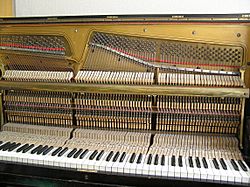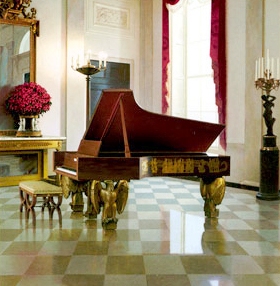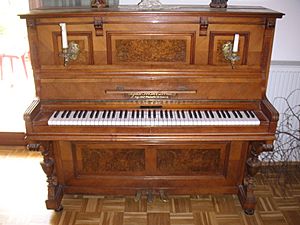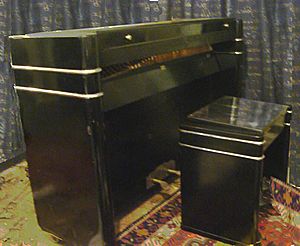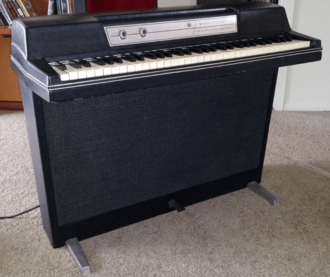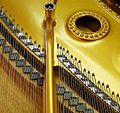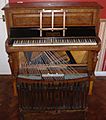Piano facts for kids
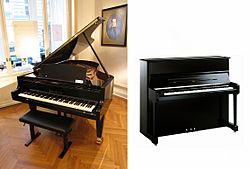
A grand piano (left) and an upright piano (right)
|
|
| Keyboard instrument | |
|---|---|
| Hornbostel–Sachs classification | 314.122-4-8 (Simple chordophone with keyboard sounded by hammers) |
| Inventor(s) | Bartolomeo Cristofori |
| Developed | Early 18th century |
| Playing range | |
The piano (or pianoforte) is a musical instrument with a keyboard. A normal piano has 88 keys. Pianos use the keys to move hammers that hit strings inside, making a sound.
Pianos come in two basic types: grand pianos and upright pianos. The piano has been an extremely popular instrument in Western classical music since the late 18th century. A person who plays the piano is called a pianist.
Contents
History
The piano was invented by Bartolomeo Cristoffori of Padua, Italy. He made his first piano in 1709. It developed from the clavichord which looks like a piano but the strings of a clavichord are hit by a small blade of metal called a “tangent”. In the piano the strings are hit by a block of wood called a hammer. The early keyboarded instruments, such as the clavichords, harpsichords and organs that were used at that time, had a much shorter keyboard than they do today. Gradually the keyboard became longer until it had the 88 notes (7 octaves plus three notes) of the modern piano.
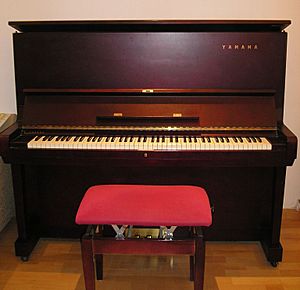
The upright piano was invented in 1800 by John Isaac Hawkings. Seven years later T. Southwell invented “overstringing”. This means that the strings for the low notes go diagonally across the soundboard so that they can be longer and make a much bigger sound.
In 1825 the cast-iron frame was invented in America. This made the piano much stronger so that it could make a bigger sound and the strings were not likely to break.
Piano parts
A piano has a keyboard with white keys and black keys. When a key is pressed down, the damper comes off the string and a hammer hits the string. It hits it very quickly and bounces off so that the string is free to vibrate and make a sound. When the player takes his finger off the key the damper falls back onto the string and the sound stops. The strings are stretched very tightly across the frame, passing over a bridge on the way. The bridge touches the soundboard. This means that the vibrations are sent to the soundboard. The soundboard is a very important part of the piano. If it is damaged the piano will not make a sound.
The mechanism which makes the hammer bounce off the string very quickly is called the “escapement”. In 1821 Sebastian Erard invented a kind of double escapement. This made it possible to repeat the note very quickly. The hammer only touches the string for about one thousandth of a second. The hammers are covered with felt which is a mixture of wool, silk and hair.
The piano has two pedals. Larger pianos have three.
- The damper pedal - this pedal is on the right. When a pianist presses it down with his right foot, any notes he plays will keep on sounding even when he takes his finger(s) off the note(s). This is because there are dampers (they look a bit like the hammers) that rest on all the strings. When the pianist holds the right pedal down all the dampers come off the strings so that the strings are free to vibrate. When a note is played, that note will continue to sound. Some other strings will also vibrate very lightly (this is called “sympathetic vibration”). It will make the sound smoother and richer. Pianists have to learn how to use the pedal well. This will depend on such things as the style of the music, the size of the piano, the size of the room and whether there is a lot of furnishing there.
- The soft pedal - the soft pedal is on the left. When a pianist presses it down with his left foot, the notes sound quieter. On a grand piano the whole keyboard and action shift a bit to the left so that the hammers only hit two strings instead of three. Also the parts of the felt which hit the string are softer because they have not become hard with lots of use. The soft pedal is normally kept down for the whole of a piece or the whole of a section of a piece. This pedal is sometimes called the una corda pedal. Una corda means: one string. This is because in the early pianos it was possible to press the pedal a little way so that the hammers hit two strings, then press it further so that they hit only one string. This is why the sign to tell a pianist to use the left pedal is “una corda”. To cancel the left pedal the composer writes “tre corde” (“three strings”) in the music.
- The middle pedal is called the sostenuto pedal. Like the right pedal, it keeps the sound going, but it only affects notes that are already being played at the moment when the middle pedal is pressed down. This makes it possible to keep one chord going while playing other notes that will not carry on. All concert grand pianos have a sostenuto pedal, and some modern upright pianos do as well. Some upright pianos have a middle pedal that is not a sostenuto pedal at all, but a practice pedal. It places a piece of cloth in front of the strings, that makes the sound very quiet indeed so that a pianist can practise without disturbing other people. The sound of a piano with a practice piano is very limited and different. The practice pedal can usually be pressed down and put in a slot so that it will stay in place.
Famous piano composers
Once the piano became popular in the late 18th century many composers wrote music for the piano. Wolfgang Amadeus Mozart started to learn on harpsichords when he was very small, but the piano was becoming popular when he was a young man and he wrote many sonatas and concertos for the piano. Franz Joseph Haydn also wrote a lot of piano music. Ludwig van Beethoven was a very famous pianist before he became very famous as a composer. His piano compositions include 5 concertos and 32 sonatas. In the Romantic period many composers wrote for the piano. They include Franz Schubert, Robert Schumann, Johannes Brahms, Franz Liszt and Frederic Chopin. Later composers include Sergei Rachmaninoff, Claude Debussy, Maurice Ravel, Sergei Prokofiev, Dmitri Shostakovich and Bela Bartok.
Famous piano players
Some famous piano players from the early days of the piano include Dussek, Mozart, Muzio Clementi, John Field and Chopin. In the 19th century Franz Liszt was a very great influence on the piano by composing and performing very difficult music. Other great pianists include Clara Schumann and Anton Rubinstein. 20th century pianists include Artur Schnabel, Vladimir Horowitz, Josef Hofmann, Wilhelm Kempff, Dinu Lipati, Claudio Arrau, Artur Rubinstein, Sviatoslav Richter and Alfred Brendel. Among the greatest pianists today are Vladimir Ashkenazy, Daniel Barenboim, Leif Ove Andsnes, Boris Berezovsky and Evgeny Kissin.
Pianists who play popular music include Liberace, Jerry Lee Lewis, Little Richard, Elton John, Billy Joel, Thelonious Monk, Tori Amos and Ray Charles. Perhaps the greatest jazz pianist was Fats Waller.
Playing the piano
The piano has been a very popular instrument ever since the mid 18th century when it soon replaced the clavichord and the harpsichord. By the early 19th century the sound that the piano made was big enough to fill large concert halls. Smaller pianos were made for use in people’s homes. At first these included square pianos and giraffe pianos, later on the upright pianos became popular for home use. Pianos are not often used in orchestras (if they are, they are part of the percussion section). They may, however, be used for piano concertos (pieces for solo pianist accompanied by orchestra). There is a vast amount of music written for piano solo. The piano can also be used together with other instruments, in jazz groups, and for accompanying singing.
Keyboard
In the early years of piano construction, keys were commonly made from sugar pine. In the 2010s, they are usually made of spruce or basswood. Spruce is typically used in high-quality pianos. Black keys were traditionally made of ebony, and the white keys were covered with strips of ivory. However, since ivory-yielding species are now endangered and protected by treaty, or are illegal in some countries, makers use plastics almost exclusively. Also, ivory tends to chip more easily than plastic. Legal ivory can still be obtained in limited quantities. Yamaha developed a plastic called Ivorite intended to mimic the look and feel of ivory; other manufacturers have done likewise.
Almost every modern piano has 52 white keys and 36 black keys for a total of 88 keys (seven octaves plus a minor third, from A0 to C8). Many older pianos only have 85 keys (seven octaves from A0 to A7). Some piano manufacturers have extended the range further in one or both directions. For example, the Imperial Bösendorfer has nine extra keys at the bass end, giving a total of 97 keys and an eight octave range. These extra keys are sometimes hidden under a small hinged lid that can cover the keys to prevent visual disorientation for pianists unfamiliar with the extra keys, or the colours of the extra white keys are reversed (black instead of white). More recently, Australian manufacturer Stuart & Sons created a piano with 108 keys, going from C0 to B8, covering nine full octaves. The extra keys are the same as the other keys in appearance.
The extra keys are added primarily for increased resonance from the associated strings; that is, they vibrate sympathetically with other strings whenever the damper pedal is depressed and thus give a fuller tone. Only a very small number of works composed for piano actually use these notes.
Toy piano company Schoenhut manufactures grands and uprights with only 44 or 49 keys and a shorter distance between the keyboard and the pedals. These are true pianos with working mechanisms and strings.
Playing and technique
As with any other musical instrument, the piano may be played from written music, by ear, or through improvisation. While some folk and blues pianists were self-taught, in Classical and jazz, there are well-established piano teaching systems and institutions, including pre-college graded examinations, university, college and music conservatory diplomas and degrees, ranging from the B.Mus. and M.Mus. to the Doctor of Musical Arts in piano.
Piano technique evolved during the transition from harpsichord and clavichord to fortepiano playing, and continued through the development of the modern piano. Changes in musical styles and audience preferences over the 19th and 20th century, as well as the emergence of virtuoso performers, contributed to this evolution and to the growth of distinct approaches or schools of piano playing. Although technique is often viewed as only the physical execution of a musical idea, many pedagogues and performers stress the interrelatedness of the physical and mental or emotional aspects of piano playing. Well-known approaches to piano technique include those by Dorothy Taubman, Edna Golandsky, Fred Karpoff, Charles-Louis Hanon and Otto Ortmann.
Types
Modern pianos have two basic configurations, the grand piano and the upright piano, with various styles of each. There are also specialized and novelty pianos, electric pianos based on electromechanical designs, electronic pianos that synthesize piano-like tones using oscillators, and digital pianos using digital samples of acoustic piano sounds.
Grand
In grand pianos the frame and strings are horizontal, the strings extend away from the keyboard. Grand pianos range in length from approximately 1.5 meters (4 ft 11 in) to 3 meters (9 ft 10 in).
- Baby grand – around 1.5 meters (4 ft 11 in)
- Parlor grand or boudoir grand – 1.7 to 2.2 meters (5 ft 7 in – 7 ft 3 in)
- Concert grand – between 2.2 and 3 meters (7 ft 3 in – 9 ft 10 in))
All else being equal, longer pianos with longer strings have larger, richer sound. Smaller grands satisfy the space and cost needs of domestic use; as well, they are used in some small teaching studios and smaller performance venues.
Upright
Upright pianos, also called vertical pianos, are more compact due to the vertical structure of the frame and strings. The mechanical action structure of the upright piano was invented in London, England in 1826 by Robert Wornum. Ipright models became the most popular model for domestic use. Upright pianos took less space than a grand piano, and as such they were a better size for use in private homes for domestic music-making and practice. The hammers move horizontally. Upright pianos are generally less expensive than grand pianos. Upright pianos are widely used in churches, community centers, schools, music conservatories and university music programs as rehearsal and practice instruments, and they are popular models for in-home purchase.
Specialized
- toy piano, introduced in the 19th century; it is a small piano-like instrument, that generally uses round metal rods to produce sound, rather than strings.
- player piano, ivented by Henri Fourneaux in 1863. It plays itself from a piano roll.
- silent piano is an acoustic piano that allows to silence the strings. They are designed for private silent practice, to avoid disturbing others.
- transposing piano, invented in 1801 by Edward Ryley. This rare instrument has a lever under the keyboard to move the keyboard relative to the strings, so a pianist can play in a familiar key while the music sounds in a different key.
- the minipiano
- the prepared piano has objects placed inside it to alter its sound, or has had its mechanism changed in some other way. The scores for music for prepared piano specify the modifications, for example, instructing the pianist to insert pieces of rubber, paper, metal screws, or washers in between the strings. These objects mute the strings or alter their timbre.
- pedal piano is a rare type of piano that has a pedal keyboard at the base, designed to be played by the feet.
Electric, electronic, and digital
With technological advances, amplified electric pianos (1929), electronic pianos (1970s), and digital pianos (1980s) have been developed.
The electric piano became a popular instrument in the 1960s and 1970s genres of jazz fusion, funk music and rock music.
Electronic pianos are non-acoustic; they do not have strings, tines or hammers, but are a type of analog synthesizer that simulates or imitates piano sounds using oscillators and filters that synthesize the sound of an acoustic piano. They must be connected to a keyboard amplifier and speaker to produce sound (however, some electronic keyboards have a built-in amp and speaker). Alternatively, a person can play an electronic piano with headphones in quieter settings.
Digital pianos are also non-acoustic and do not have strings or hammers. They use digital audio sampling technology to reproduce the acoustic sound of each piano note accurately. They also must be connected to a power amplifier and speaker to produce sound (however, most digital pianos have a built-in amp and speaker). Alternatively, a person can practise with headphones to avoid disturbing others.
Perfomance styles
Many classical music composers, including Haydn, Mozart, and Beethoven, composed for the fortepiano, a rather different instrument than the modern piano. Even composers of the Romantic movement, like Franz Liszt, Frédéric Chopin, Clara and Robert Schumann, Fanny and Felix Mendelssohn, and Johannes Brahms, wrote for pianos substantially different from 2010-era modern pianos. Contemporary musicians may adjust their interpretation of historical compositions from the 1600s to the 1800s to account for sound quality differences between old and new instruments or to changing performance practice.
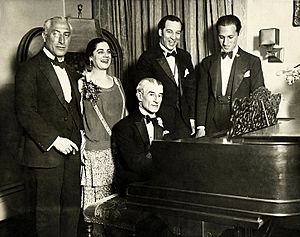
Starting in Beethoven's later career, the fortepiano evolved into an instrument more like the modern piano of the 2000s. Modern pianos were in wide use by the late 19th century. They featured an octave range larger than the earlier fortepiano instrument, adding around 30 more keys to the instrument, which extended the deep bass range and the high treble range. Factory mass production of upright pianos made them more affordable for a larger number of middle-class people. They appeared in music halls and pubs during the 19th century, providing entertainment through a piano soloist, or in combination with a small dance band. Just as harpsichordists had accompanied singers or dancers performing on stage, or playing for dances, pianists took up this role in the late 1700s and in the following centuries.
During the 19th century, American musicians playing for working-class audiences in small pubs and bars, particularly African-American composers, developed new musical genres based on the modern piano. Ragtime music, popularized by composers such as Scott Joplin, reached a broader audience by 1900. The popularity of ragtime music was quickly succeeded by Jazz piano. New techniques and rhythms were invented for the piano, including ostinato for boogie-woogie, and Shearing voicing. George Gershwin's Rhapsody in Blue broke new musical ground by combining American jazz piano with symphonic sounds. Comping, a technique for accompanying jazz vocalists on piano, was exemplified by Duke Ellington's technique. Honky-tonk music, featuring yet another style of piano rhythm, became popular during the same era. Bebop techniques grew out of jazz, with leading composer-pianists such as Thelonious Monk and Bud Powell. In the late 20th century, Bill Evans composed pieces combining classical techniques with his jazz experimentation. In the 1970s, Herbie Hancock was one of the first jazz composer-pianists to find mainstream popularity working with newer urban music techniques such as jazz-funk and jazz-rock.
Pianos have also been used prominently in rock and roll and rock music by performers such as Jerry Lee Lewis, Little Richard, Keith Emerson (Emerson, Lake & Palmer), Elton John, Ben Folds, Billy Joel, Nicky Hopkins, and Tori Amos, to name a few. Modernist styles of music have also appealed to composers writing for the modern grand piano, including John Cage and Philip Glass.
Interesting facts about piano
- Although the piano was invented at the beginning of the 18th century, it was not until 50 years later that it started to become popular.
- At first the instrument was called the “fortepiano”, which means “loud-soft” in Italian. It was given this name because it could be played either loudly or softly, depending on how hard the note was hit. Later this name was changed to “pianoforte”.
- The early pianos had strings that were fastened to a frame made of wood. They were not very heavy, but they were not very strong or loud, so they could not be heard very well in a big concert hall.
- In some languages, such as Russian, “fortepiano” is the normal word for a piano.
- In 1768, Johann Christian Bach was the first to play the piano in public at a concert in London.
Images for kids
-
1720 fortepiano by Italian maker Bartolomeo Cristofori, the world's oldest surviving piano, Metropolitan Museum of Art, New York City
-
Duplex scaling of an 1883 Steinway Model 'A'. From lower left to upper right: main sounding length of strings, treble bridge, duplex string length, duplex bar (nickel-plated bar parallel to bridge), hitchpins, plate strut with bearing bolt, plate hole
-
Cast iron plate of a grand piano
-
The piano was the centrepiece of social life in the 19th-century upper-middle-class home (Moritz von Schwind, 1868). The man at the piano is composer Franz Schubert (1797–1828).
See also
 In Spanish: Piano para niños
In Spanish: Piano para niños



